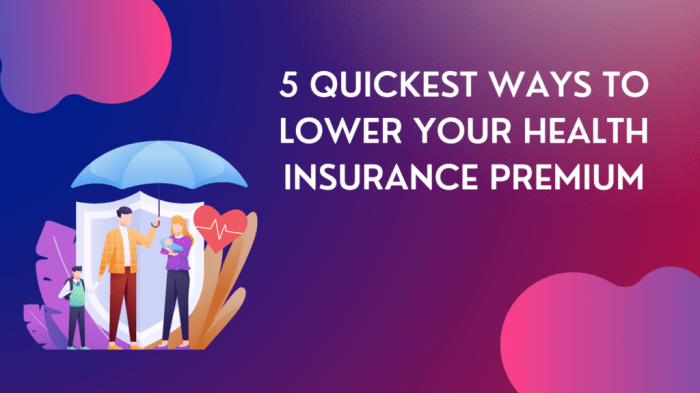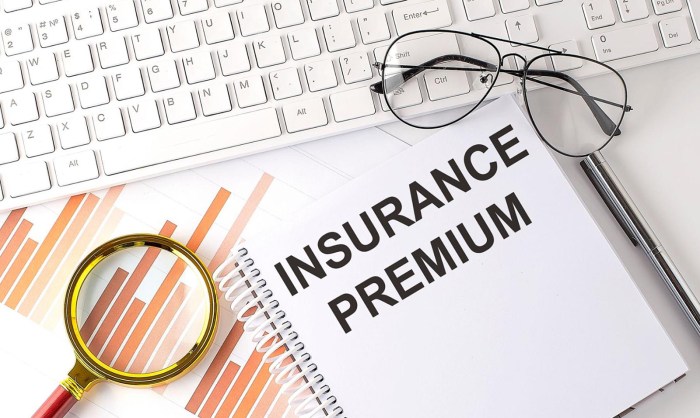Insurance premiums can feel like a significant drain on your finances. Understanding the factors that influence these costs, however, empowers you to take control and potentially save a substantial amount of money each year. This guide explores effective strategies to lower your insurance premiums, from improving your driving record to strategically choosing coverage and leveraging available discounts. We’ll equip you with the knowledge to navigate the complexities of insurance and secure more affordable rates.
By examining your driving habits, insurance coverage, and financial practices, you can identify specific areas for improvement. We will delve into the mechanics of insurance pricing, explore various policy options, and highlight the often-overlooked opportunities for savings. Ultimately, our goal is to help you secure the best possible insurance protection at a price that aligns with your budget.
Understanding Your Insurance Premium

Understanding your insurance premium is crucial for managing your finances effectively. Premiums are the price you pay for insurance coverage, and several factors influence their amount. Knowing these factors allows you to make informed decisions and potentially lower your costs.
Factors Influencing Insurance Premiums
Numerous factors contribute to the calculation of your insurance premium. These factors vary depending on the type of insurance, but common influences include your risk profile, the coverage amount, and the insurer’s operational costs. For example, a driver with a history of accidents will typically pay more for car insurance than a driver with a clean record. Similarly, higher coverage limits naturally result in higher premiums.
Types of Insurance and Associated Costs
Different types of insurance carry varying costs. Auto insurance, for instance, is influenced by factors like vehicle type, driving history, and location. Homeowners insurance considers factors such as the property’s value, location, and construction materials. Health insurance premiums depend heavily on the plan’s coverage, your age, and your health status. Life insurance premiums are determined by factors such as the policy’s death benefit, the insured’s age and health, and the type of policy (term or whole life).
Insurance Premium Calculation
Insurance companies use complex actuarial models to calculate premiums. These models analyze historical data, statistical probabilities, and risk assessments to predict the likelihood of claims. The formula is not a simple equation, but rather a sophisticated algorithm incorporating numerous variables. Essentially, the insurer estimates the potential cost of claims for a specific group of policyholders and distributes that cost among them in the form of premiums. A higher likelihood of claims for a particular group leads to higher premiums for that group.
Comparison of Premium Factors Across Insurance Types
The following table illustrates some key factors influencing premiums across different insurance types. It’s important to remember that these are simplified examples, and the specific factors and their relative importance can vary significantly between insurers and specific policies.
| Insurance Type | Factor 1 | Factor 2 | Factor 3 |
|---|---|---|---|
| Auto Insurance | Driving Record (accidents, violations) | Vehicle Type & Value | Location (risk of theft, accidents) |
| Homeowners Insurance | Property Value | Location (risk of natural disasters) | Home Security Features |
| Health Insurance | Age | Pre-existing Conditions | Plan Coverage Level |
| Life Insurance | Age | Health Status | Policy Type (Term vs. Whole Life) |
Improving Your Driving Record

Maintaining a clean driving record is crucial for keeping your car insurance premiums low. Insurance companies assess risk based on your driving history, and a history of accidents or violations significantly increases your perceived risk, leading to higher premiums. By focusing on safe driving practices and understanding the impact of infractions, you can significantly reduce your insurance costs.
Impact of Traffic Violations and Accidents on Insurance Costs
Traffic violations and accidents directly influence your insurance premiums. Each incident adds points to your driving record, which insurance companies use to calculate your risk profile. Minor violations like speeding tickets might result in a modest premium increase, while more serious offenses, such as reckless driving or DUI, can lead to substantially higher premiums or even policy cancellation. Similarly, accidents, regardless of fault, typically result in a significant increase in premiums, reflecting the increased risk associated with your driving. The severity of the accident, the amount of damage, and the number of injuries involved all factor into the premium increase. For example, a minor fender bender might increase premiums by a few hundred dollars annually, while a serious accident causing significant property damage or injuries could lead to thousands of dollars in increased premiums over several years.
Defensive Driving Courses and Their Effect on Premiums
Many insurance companies offer discounts for completing a defensive driving course. These courses teach safe driving techniques, hazard recognition, and accident avoidance strategies. Successful completion demonstrates a commitment to safe driving and can lead to a reduction in your premiums. The discount amount varies depending on the insurer and the specific course, but it can often be a substantial percentage of your overall premium. Some insurers even mandate completion of a defensive driving course after a certain number of violations or accidents to maintain coverage.
Appealing a Traffic Ticket
Appealing a traffic ticket is a process that can potentially remove points from your driving record, preventing a premium increase. A step-by-step guide to appealing a traffic ticket might include:
- Review the ticket carefully: Note the date, time, location, and the specific violation listed. Check for any errors or inconsistencies.
- Gather evidence: This could include photographs of the scene, witness statements, or dashcam footage supporting your case.
- File an appeal within the designated timeframe: This timeframe is usually specified on the ticket itself. Failure to file within the time limit may result in the inability to appeal.
- Attend the hearing: Be prepared to present your evidence and explain your case clearly and concisely to the judge or hearing officer.
- Consider legal representation: For complex cases or serious violations, consulting a traffic attorney can significantly improve your chances of a successful appeal.
Successfully appealing a ticket can save you money on insurance premiums and prevent points from being added to your driving record. However, it’s important to remember that appealing a ticket requires careful preparation and a strong case.
Choosing the Right Coverage
Selecting the appropriate insurance coverage is crucial for managing your premiums effectively. Understanding the different coverage options and their impact on your costs allows you to tailor your policy to your specific needs and budget. This involves balancing the level of protection you desire with the associated premium costs.
Minimum Coverage Requirements and Costs
Each state mandates minimum liability coverage levels, protecting you financially in case you’re responsible for an accident causing injury or property damage to others. These minimums vary significantly by state. For example, some states might require only $25,000 per person/$50,000 per accident for bodily injury liability, while others may demand substantially higher limits. Failing to meet these minimums can result in hefty fines and legal ramifications. The cost of minimum coverage is generally the lowest but offers the least protection. It’s important to check your state’s Department of Insurance website to determine the exact minimum requirements and typical associated costs. These costs are heavily influenced by factors like your driving record, vehicle type, and location.
Benefits of Higher Coverage Limits and Associated Costs
While minimum coverage fulfills legal obligations, it might leave you significantly exposed financially in the event of a serious accident. Higher coverage limits, such as increasing your bodily injury liability or property damage liability, provide greater financial protection. For instance, a higher limit on bodily injury liability can cover extensive medical bills and lost wages for those injured in an accident you caused. Similarly, a higher property damage liability limit protects you against significant repair or replacement costs for damaged vehicles or property. The increased protection offered by higher limits comes at a higher premium cost. However, the added expense can be worthwhile considering the potential for substantial financial liability without adequate coverage.
Comparison of Different Coverage Levels and Premium Differences
The following table illustrates how different coverage levels impact premiums. Note that these are illustrative examples and actual costs will vary depending on individual circumstances and location. Always obtain quotes from multiple insurers for accurate pricing.
| Coverage Type | Coverage Limit | Premium Cost (Example) | Benefits |
|---|---|---|---|
| Bodily Injury Liability | $25,000/$50,000 | $500/year | Meets minimum state requirements; protects against claims up to specified limits. |
| Bodily Injury Liability | $100,000/$300,000 | $650/year | Significantly increased protection against substantial medical and legal costs. |
| Property Damage Liability | $25,000 | $400/year | Covers damage to other vehicles or property up to the limit. |
| Property Damage Liability | $100,000 | $500/year | Greater protection against high repair or replacement costs for damaged property. |
Wrap-Up

Lowering your insurance premium is achievable through a combination of proactive measures and informed decision-making. By understanding the factors influencing your premiums and actively pursuing strategies to improve your risk profile, you can significantly reduce your annual costs. Remember, consistent effort and careful planning are key to achieving long-term savings. Take the time to review your policy regularly, shop around for better rates, and seize every opportunity to lower your premiums. The financial rewards are well worth the effort.
Common Queries
What is the impact of a DUI on my insurance premiums?
A DUI conviction will significantly increase your insurance premiums, often resulting in higher rates for several years. The increase depends on your insurer and the specifics of the offense.
Can I lower my premium by switching to a less powerful car?
Yes, the type of vehicle you insure affects your premium. Cars with lower horsepower and better safety ratings often come with lower premiums.
How often should I shop around for insurance?
It’s advisable to compare quotes from different insurers annually, or even more frequently, as rates can change significantly.
What is the difference between liability and collision coverage?
Liability coverage pays for damages you cause to others, while collision coverage covers damage to your own vehicle in an accident, regardless of fault.
Does my credit score really affect my insurance rates?
In many states, your credit score is a factor in determining your insurance premiums. A higher credit score generally leads to lower rates.